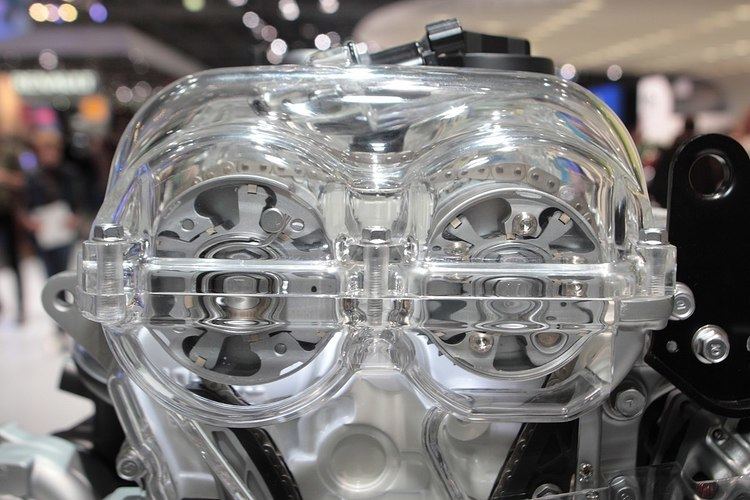 | ||
Variable valve timing (VVT) is a system for varying the valve opening of an internal combustion engine. This allows the engine to deliver high power, but also to work tractably and efficiently at low power. There are many systems for VVT, which involve changing either the relative timing, duration or opening of the engine's inlet and exhaust valves.
Contents
One of the first practical VVT systems used a variator to change the phase of the camshaft and valves. This simple system cannot change the duration of the valve opening, or their lift. Later VVT systems, such as the helical camshaft or the movable fulcrum systems, could change these factors too. Despite this limitation, the variator is a relatively simple device to add to an existing engine and so they remain in service today.
As the benefit of the variator relies on changing the relative timing between inlet and exhaust, variator systems are only applied to double overhead camshaft engines. A variator system that moved a single camshaft for both inlet and exhaust would be possible, but would have no performance benefit.
Alfa Romeo system
In 1970, Fiat patented a variable valve timing system, however it was Alfa Romeo who first applied VVT in 1980 to the long-established Twin Cam engine used in the Alfa Romeo Spider. The technique derives from work carried in the 1970s by Ing. Giampaolo Garcea and in Italian the device is termed variatore di fase. The Alfa Romeo Twin Spark engine, introduced in the 1987 Alfa Romeo 75, also uses variable valve timing.
The Alfa system varies the phase (not the duration) of the cam timing and operates on the inlet camshaft.
Alfa Romeo's variator is a cylindrical chamber that contains a pressure chamber and piston along with helical splines. Engine oil pressure, moves the internal piston which rotates slightly due to the helical splines and advances the inlet valve timing by 25 degrees. Oil flow to the variator is controlled by a solenoid valve. When engine speed reaches a certain speed, normally 1500-2000 rpm in the Twin Spark application, the solenoid energises, causing pressurised oil to be directed through the inlet camshaft into the variator. The inlet camshaft position is advanced 25 degrees, thus increasing valve overlap. It remains in this advanced state until about 5000 rpm when the solenoid switches off, and the variator piston returns the valve timing to its natural state. The variable timing increases the engine's mid-range flexibility and reduces emissions. Exact changeover points depend on version. It is notable that this relatively early system only has two settings: unchanged and fully advanced.
Applications
Reliability
Although the variator rarely fails outright, it developed a poor reputation for unreliability and requiring a relatively expensive repair. This reputation was made worse by the perception of the variator as a component that other cars managed entirely without, and Alfa's previous reputation for mechanical reliability already made them susceptible to such criticism.
If the petrol engine sounds like a diesel briefly after starting, it means that the variator splines are worn and should be replaced. This was a regular occurrence for the 16 valve Twin Spark. When worn, the noise remains until about 1500 rpm and a slight loss of performance but not fail completely.
From the original variator that controls the cam timing is prone to wear or jam, The replacement part carries a different part number and has improved reliability.
Volkswagen system
Volkswagen use a variator system with two variators, one for each camshaft. Like the Alfa Romeo system, these are electrically-controlled hydraulic units, mounted in the camshaft's timing belt pulley. These systems are fitted to the Volkswagen VR5 and VR6 engines, and also to the W8 and W12 engines. The multiple-bank W engines have four variators in total, one for each camshaft.
The Volkswagen variator is referred to as a 'fluted variator', owing to the shape of the hydraulic components. Unlike the Alfa Romeo system with its helical splines and indirect actuation, the Volkswagen system has a direct rotational action. The internal components of the variator resemble a paddle wheel inside a loose casing, so that it is free to move a few degrees from side to side. By applying hydraulic pressure on one side of these paddles, a phase shift is achieved. The hydraulic fluid is engine oil, controlled by a solenoid valve mounted on the cylinder head and controlled by the ECU. A Hall effect sensor also monitors the camshaft position.
